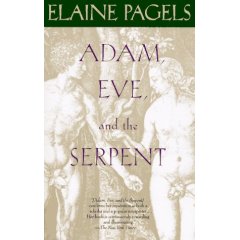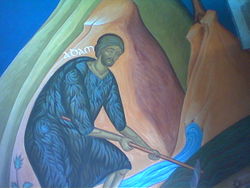
The story of Adam and Eve and the expulsion from the garden has been dubbed "the Fall" in Christian theology. But is the story really about that?
Elaine Pagels wrote a brilliant book,
Adam, Eve, and the Serpent. She wrote about the myth of Adam and Eve and the subsequent traditions that have interpreted this myth in Christian theology.
Read a review here.
Genesis 2:4(b)-4:16 is the story of Adam, Eve and the Serpent. This story is the product of the Jahwist or (J) writing between the 10th and 8th century BCE. This story predates the first creation account, Genesis 1:1-2:4(a), written by "P" in the 6th century BCE. A careful reading reveals a seam in Genesis 2:4. Even in English you can pick out the different writing styles between "P" and "J". The point is that the earlier creation account began with Genesis 2:4b.

For an interesting account of J, read Harold Bloom's
The Book of J
J's creation story begins with the creation of adam (which means ground or earth) from the dust of the earth (adamah). The Lord then plants a garden, Eden, and places the adam. Then the Lord out of the ground plants trees and food to eat including the tree of knowledge of good and evil. The Lord commands the adam not to eat of this tree, "for in the day that you shall eat of it you shall die.
The Lord decides that the adam needs a partner. The Lord then creates animals, but none are suitable as a partner. The Lord makes the adam fall asleep and from his rib creates a woman. The adam likes this plan. "Therefore a man leaves his father and mother and clings to his wife, and they become one flesh." (SEX)
 Michelangelo's Temptation and Fall from the ceiling of the Sistine Chapel.
Michelangelo's Temptation and Fall from the ceiling of the Sistine Chapel.Enter the serpent, wily and crafty, and convinces the woman to eat of the tree of knowledge of good and evil. She eats, gives some to the adam and he eats. "Then the eyes of both were opened and they knew that they were naked."
They cover themselves with fig leaves. No hiding from the Lord, though. He comes for his evening walk looking for them. He finds them and they are in trouble.
The adam blames the woman who blames the serpent who is cursed first by the Lord. Then the woman is cursed with "increased pangs in childbirth" and the adam is cursed with having to work for a living.
The adam names the woman, Eve, mother of all living. The Lord sews garments for them.
Then an odd turn. The Lord becomes introspective (or converses with the other gods) and realizes that these two cannot stay in the garden because if so, they could eat the tree of life (immortality) and be like the gods. So the Lord drives them East of Eden and places guards at the gate.

Adam Workin' for a Livin'
Outside the gate, the man and the woman reproduce and bear Cain "who tills the ground" and Abel "who tends sheep." They have a brothers' quarrel and the Lord prefers Abel's gift. Cain becomes angry and is warned by the Lord to watch out for sin who like a lion lurks at the door.
Cain cannot control his sin and kills his brother. The Lord puts a mark on him and sends him to the land of Nod.
It should be fairly obvious that this is a story, legend, myth, or fiction by any name you use. These people never existed except in the imaginations of the storytellers. It is a story to answer a number of questions, such as why do snakes bite? Why do humans blame each other for their troubles? Why do we have to work and toil and sweat? Why is childbearing painful? Why do we die?
This story is drawn from a number of mythologies that are precursors.
Summerian mythology contained many of the raw elements and motifs. The following is from Wikipedia, which I think does a pretty good job in drawing comparisons:
"In Sumerian myth the senior gods spent their time in leisure, while the junior gods laboured at digging the channels of the rivers and other tasks. Eventually the junior gods rebelled and threatened to overturn the heavenly order. The senior god Enki therefore fashioned the first men from clay, mixed with spittle and the blood of a slain god, so that men could work and the gods could rest. Originally Enki made seven men and seven women, but the numbers of mankind soon multiplied. In another Sumerian myth the goddess Ninhursag created a beautiful garden full of lush vegetation and fruit trees, called Edinu, in Dilman, the Sumerian earthly Paradise, a place which the Sumerians believed to exist to the east of their own land, beyond the sea. Ninhursag charged Enki, her lover, with controlling the wild animals and tending the garden, but Enki became curious about the garden and his assistant, Adapa, selected seven plants and offered them to Enki, who ate them. (In other versions of the story he seduced in turn seven generations of the offspring of his divine marriage with Ninhursag). This enranged Ninhursag, and she caused Enki to fall ill. Enki felt pain in his rib, which is a pun in Sumerian, as the word "ti" means both "rib" and "life. The other gods persuaded Ninhursag to relent. Ninhursag then created a new goddess named Ninti, (a name made up of "Nin", or "lady", plus "ti", and which can be translated as both Lady of Living and Lady of the Rib), to cure Enki. Ninhursag is known as mother of all living creatures, and thus holds the same position as Eve. The story has a clear parallel with Eve's creation from Adam's rib, but given that the pun with rib is present only in Sumerian, linguistic criticism places the Sumerian account as the more ancient.

Enki and Ninhurshag
By the Babylonian era, Enki's place was taken by Adapa Uan (the Oannes of Berossus), a human created by Enki as advisor to the first king of Enki's city of Eridu. A 14th century BC tablet refers to Adapa as the seed of humankind. One myth recounts that Adapa broke the wings of the wind in anger at being disturbed while fishing, and was called to the heavens to answer for doing so. He was warned by Enki to apologise for his actions, but not to touch the food, in case it had been poisoned in revenge. The gods, impressed by his penitence, set the food and drink of immortality before him, but Adapa heeded Enki's warning and refused the food, thus missing out on immortality. The god who offered the food and drink of immortality was the wily serpent-god Ningishzida. In the Biblical account the serpent offers knowledge, but he also says to Eve that she shall not die. As the food and drink of the gods originated on earth, somewhere on earth must lie the source of the food and drink of immortality, a Tree of Life. In the biblical account the fruit of knowledge of good and evil is consumed, not rejected, and the couple are punished by being expelled from the garden for disobeying Gods command to not eat the fruit of that tree. Thus any derivation of the biblical account from Sumerian and Babylonian mythology involves the confusion of the tales of Adapa and Enki. Such a conflation may have been influenced by a story preserved in the prologue of Gilgamesh, Enkidu and the Underworld. In this tale, the goddess Inanna, who gains knowledge of sex by descending to earth and eating from various plants and fruits, transplants the huluppu tree from the Euphrates to her own garden, but a wicked serpent made its nest amongst the roots of the tree. This tale connects the serpent to the garden, and with the presence of Inanna, the theme of lust. Moving the story of Enki's rib to the start of the Biblical story would allow the failure to gain immortality to be seen as punishment for eating the fruit."
The story of Adam and Eve has no historical or factual value. It is a myth. So, what can we take from this? Much of Christian theology (Paul and later Augustine) has taken this story to be the "Fall" of humankind and the introduction of original sin. However, Jewish theology doesn't see it as such. Adam and Eve hardly make another appearance in the Hebrew scriptures. It is seen as the coming of age of humanity. Humankind knows the difference between right and wrong, good and evil, and is conscious (not naked like the animals).
Yahweh took a risk in creating humankind. They think for themselves and are not easily controlled. They push limits (sometimes to their own destruction). Yet they do not simply do as they are told. What if you were Eve? Would you have eaten from the tree? What if you were Adam? Would you have eaten? The answer to that question might very well define your personality.
Myths have no simple answers. They point to paradoxes within ourselves. Perhaps that is what we can take from Adam, Eve, and the Serpent.
No comments:
Post a Comment